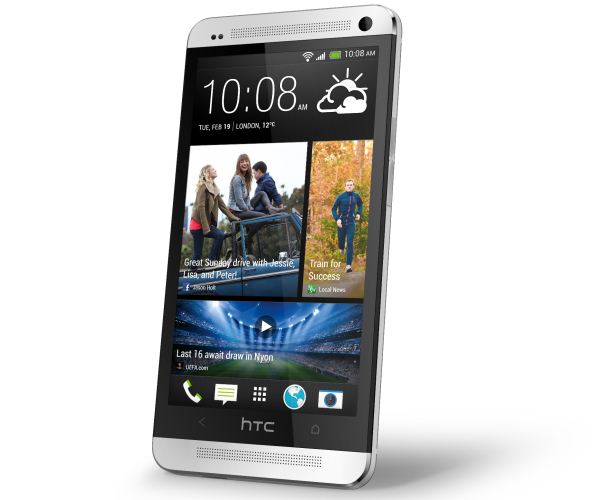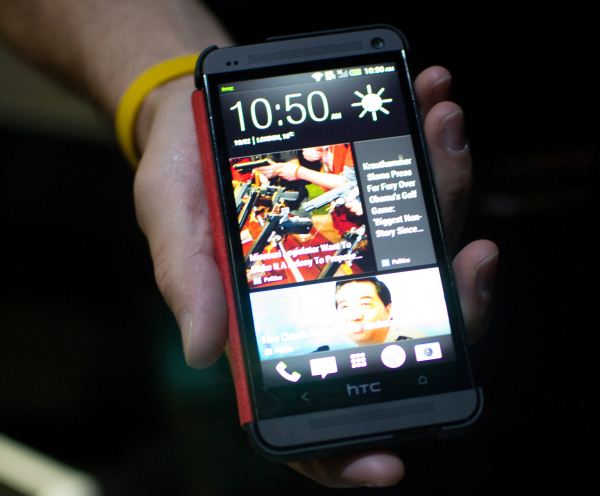Hands on and Impressions from the HTC One - Formerly M7
by Brian Klug on February 19, 2013 10:30 AM EST- Posted in
- Smartphones
- HTC
- Mobile
- HTC One
- Snapdragon 600
Software & Sense
The HTC One runs Android 4.1.2, a choice which might seem alarming, but was done for stability and quality reasons, although 4.2 is coming. I think it might sound bad to ship with 4.1, but even Google acknowledged that 4.2 was primarily a release with more tablet features than something for smartphones, after all both are still Jelly Bean. Sense 5 replaces Sense 4 or 4+ which shipped on the One X and X+, and brings a radically different themed UI this time. I was able to survive with Sense 4, and Sense 4+ brought a lot of improvements, what we’ve seen of the new Sense 5 looks like it follows more Holo design rules than any of the other OEM skins I’ve seen so far. All of the Sense UI fonts and system fonts are Roboto, the font Google made for Android 4.x, though it’s often one of the lighter condensed weights. In Sense 5, all the first party HTC applications now also use the pivot bar, which was a key design element introduced as part of the Holo guidelines. Icons and menus are now very flat in Sense 5, giving it a much more modern look, though there are still some gradients if you hunt around for them.
Probably the only huge deviation from Android is the inclusion of a completely new homescreen. Instead of having a grid of icons, the leftmost pane is home to a new feature called the Blinkfeed, which aggregates together content from a variety of online sources, media on the device (photos, videos, events), calendar events, and social media from linked accounts. The idea is to provide a quickly parsed visual menu of information to consume while glancing at the device. There are still widget panel homescreens, and the menus are sticky so that pressing home returns to the homescreen you were last on, in case you want to primarily use a widget panel as home instead of Blink.
The launcher also gets changed around in Sense 5. By default applications come sorted into logical folders, both to hint to users this is possible, and also to reduce anxiety for new users first diving into the launcher. The default view is a 3x4 grid which actually looks very refreshing, there’s still an option for a 4x5 grid for those wanting more density. Perhaps the biggest, most welcome improvement is that by default all operator applications will ship inside of a folder, rather than scattered all about the grid.
Another interesting choice is the decision to go with two capacitive buttons at the bottom of the HTC One instead of three. Last cycle, HTC got burned by following the Google guidance and doing away with the menu, err, “action overflow” button, leaving an on-screen action button in the overwhelming majority of Android applications that have yet to move away from this model. As a result, other players who included the menu button saw no black bar at the bottom. There’s also no app switcher button on the HTC One. Instead, just back and home. To get to an application switcher (which is now a 3x3 grid of thumbnails), one has to double tap the home button. Menu can be optionally enabled as a long press on the back button in a menu similar to what was added later in the One X. I think getting rid of a button is potentially risky, but probably simplifies things for new users.
Final Words
The HTC One industrial design is without a doubt the most striking I’ve seen from an Android phone to date. Unibody metal construction is something that at the high end we’ve only really seen out of Apple, and with the One, HTC has a major opportunity to set itself apart with a dramatically different in hand feel. Actively tuned antennas to make this possible without unintended attenuation, as well as improved CNC manufacturing volume are really the two enablers here.
Second only to the aluminum unibody story that is of the camera on the HTC One. HTC is taking perhaps the biggest risk of all with the camera, by choosing what is almost undeniably the right course of action and going against the prevailing trend of increasingly smaller and smaller pixels to drive the number of megapixels up. Megapixels is really the only number that has been sold to consumers, and with a 4.0 MP sensor, it’s instantly easy to see how the messaging will have to be set right for average consumers to appreciate that they’re getting around the same approximate size sensor as ship in other smartphones, if not slightly larger, but with dramatically bigger pixels. The result is, from my short time holding the HTC One next to a One X+, a dramatic difference in low light sensitivity, noise, and dynamic range indoors. The inclusion of optical image stabilization further improves things, and from a camera point of view the HTC One appears to be without a doubt the most serious Android smartphone camera experience.
HTC is announcing that in the USA the HTC One will be coming to AT&T, T-Mobile, and Sprint as the HTC One. Notably absent from that list is Verizon, unfortunately. Internationally HTC has an impressive list of operator partners, which I’ll spare going over in excruciating detail. The problem with the HTC One X wasn’t so much hardware as it was marketing and the fact that it only existed on one operator in the USA by that name. This time around, it’s one name, one brand, with no adulteration.
To say that the HTC One takes some bold risks is putting it lightly, but the hardware I’ve seen is impressive and without a doubt the best out of HTC, or any Android handset maker for that matter, to date. It’s too early to call who will be on top after this next cycle, but HTC seems well positioned with the HTC One at the top.












139 Comments
View All Comments
ramvoo - Tuesday, February 19, 2013 - link
need to see battery Tests.ChronoReverse - Tuesday, February 19, 2013 - link
Well, I'm fine with 720p in a 4.7" screen but the battery is the key. If it's not at least a full day battery, then there's no point.mmrezaie - Tuesday, February 19, 2013 - link
and now they are going to completely forget about their last phones (no android nor sense updates).but have tot say that, it looks awesome.
ImSpartacus - Tuesday, February 19, 2013 - link
The battery is nearly 9 Whr, I expect battery life to at least be passable.usopen65667268 - Tuesday, February 19, 2013 - link
Do any of you currently own a DNA? The battery life on that phone is on par or better than any other HTC phone to date. Throw in the fact that the DNA has a larger screen at 5 inches and a smaller 2020mAh battery compared to the ONE's 4.7 inch screen and 2300 mAh battery and this phone should last a day and a half at least with moderate to heavy use. I get over 4 hours of onscreen time with my DNA and anywhere between 22-36 hours of total battery life before I have to find a plug. For those of you saying batter life being marginal or passable is just flat out not true. If I had enough money I would send each of you a DNA to judge for yourselves.youwonder - Tuesday, February 19, 2013 - link
>If I had enough money I would send each of you a DNA to judge for yourselves.I support this.
Conficio - Wednesday, February 20, 2013 - link
O.K. so on an average day you can commute 2x30 min with navigation, 1h talk and 1h look at your calendar and messages, 1 h read your e-mail or browse the web and you are still dead next morning.Well, that is what I call no even passable. In real life it means:
* If I have an above average day (traveling, waiting for appointments, play a game, weekend, show off the latest pictures to family, get hit with more than a couple of app updates in a day, etc.), the phone is dead in the afternoon
* If I forget to charge over night, my phone is dead in the morning
That User Experience is horrible! Give me the option to double the battery size (Motorola got the idea with the MAX), I'm willing to take the size/weight consequences.
I have an HTC Sensation 4G and I'm spoiled by my previous TREO 600, which lasted a week.
leozno1 - Friday, February 22, 2013 - link
Okay so you are comparing today's phones battery life with a phone that is 2 years old. The batteries are much larger now, and there have been enhancements in the efficiency of cell radios and SoCs. I'm sure it will be okay. My EVO LTE easily lasts an entire day and that includes push email all day, texting all day, listening to music for about 3 or 4 hours at work, 1-2 hours of talk and 2x40 minute commutes listening to music via bluetooth. And I still have upwards of 15-20% battery left when I go to bed.Bagsen - Friday, March 15, 2013 - link
you need to use your phone's nav to commute to work every day? you forget how to get to work every night? seems like a brain battery life problem, not a phone battery life problem.cknobman - Tuesday, February 19, 2013 - link
that home screen pictured looks awfully familiar to a Windows Phone?